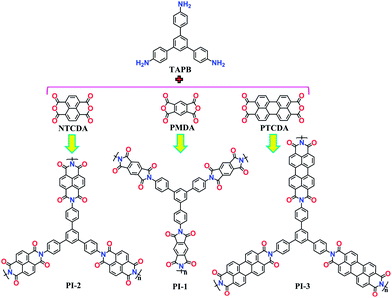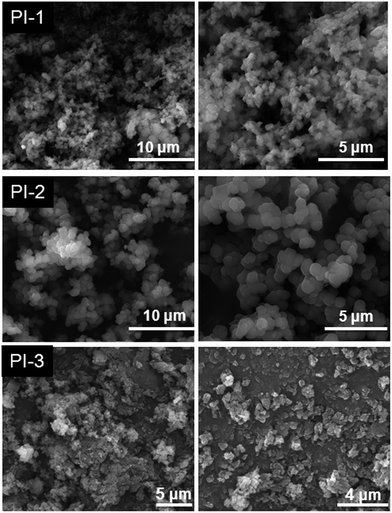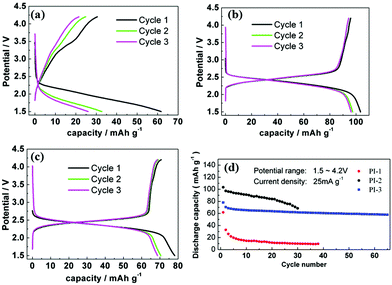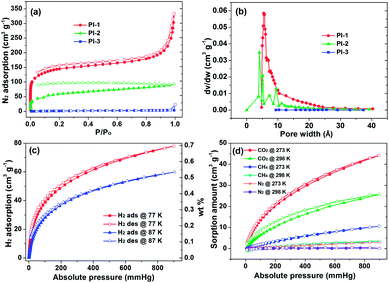Li-ion storage and gas adsorption properties of porous polyimides (PIs)†
Dan Tiana,
Hong-Zhou Zhangb,
Da-Shuai Zhanga,
Ze Chang*a,
Jie Hana,
Xue-Ping Gao*b and
Xian-He Bua
aDepartment of Chemistry, Collaborative Innovation Center of Chemical Science and Engineering (Tianjin), and Tianjin Key Lab on Metal and Molecule-based Material Chemistry, Nankai University, Tianjin 300071, China. E-mail: changze@nankai.edu.cn; Fax: +86-22-23502458
bInstitute of New Energy Material Chemistry, Nankai University, Tianjin 300071, China. E-mail: xpgao@nankai.edu.cn; Tel: +86-22-23500876
First published on 8th January 2014
Abstract
In this work, three polyimides (PIs) are successfully synthesized by the condensation reaction of an aromatic triamine with three difunctional aromatic dianhydrides. These materials show electrochemical lithium ion storage properties as cathodes for lithium-ion batteries. The aromatic dianhydride monomers are found to have significant effects on their performances. In addition, the polymer PI-1 shows narrow micropore size distributions and selective adsorption of CO2 over CH4 and N2. Furthermore, PI-1 exhibits a high Qst value (11.7 kJ mol−1) for H2 adsorption.
Recently, serious environmental pollution from the use of fossil fuels and energy storage stimulate great efforts on exploring new energy sources. As a very promising energy storage device, lithium ion batteries have received much attention from scientists. A mass of inorganic materials have been successfully developed for Li-ion storage, such as LiCoO2, LiMn2O4, LiFePO4, Co3O4, and Fe2O3.1 However, heavy metals pollution has become an increasingly severe society problem, and more and more people pay close attention to environmental protection. Therefore, from the viewpoint of sustainable development, environmentally friendly organic materials which do not contain any heavy metal have shown their advantages as alternative electrode materials.2 In addition, organic materials also possess other advantages over traditional metal materials such as large specific surface area, good chemical and physical stability, which can be widely applied in many fields.3 Among the various candidate materials, organic electrode-active materials provide an inherently novel approach to high-performance secondary batteries for their facile preparation, structural diversities, low safety risks and low cost compared with transition metal oxides.4 Furthermore, the wide diversity of organic redox systems and the excellent flexibility in the molecular design arouse greater prospects for these materials. Currently, organic electrode materials containing carbonyl groups, such as anhydrides,5 quinones,6 conjugated dicarboxylate,7 imides8 and polyketones,9 have attracted more attention and significant progress has been achieved. We are interested in polyimides due to its following features. Polyimides polymers are well-known high-performance polymers with outstanding physical and chemical properties: thermal and chemical stability, flame resistance, radiation resistance, and mechanical strength and flexibility.10 On the other hand, they have been used in a wide range of hightech industries for aerospace, electric, electronic, and optical applications.11 Organic materials containing carbonyl group were also found to show outstanding electrochemical performance5,8,12 and gas adsorption13 comparable to inorganic materials, or even better.
1,4,5,8-Naphthalenete-tracarboxylicdianhydride (NTCDA) and 3,4,9,10-perylene-tetracarboxylicacid-dianhydride (PTCDA) are well-known organic molecule semiconductors with good crystalline properties.14 They can react with polyamine to generate PIs. The carbonyl groups of PIs based on NTCDA and PTCDA can efficiently conjugate with the aromatic rings and capture Li ions. For instance, Sun's group presented the aromatic carbonyl derivative polymers which showed both high capacity and high cycling stability.5a,5b Zhan et al. reported that PIs can be promising energy-storage materials.8a However, the application of PIs based on NTCDA and PTCDA as electrode materials has been still rarely reported. Herein, we reported three PIs, PI-1, PI-2 and PI-3, which have been synthesized by the condensation reaction of A3-type cross-linker 1,3,5-tris(4-aminophenyl)-benzene (TAPB) with a series of difunctional (B2) aromatic dianhydride (Scheme 1). Their lithium ion storage properties and gas adsorption properties have been investigated. It should be noted that though Wang and co-workers have reported similar polymers based on the reaction of TAPB with 1,2,4,5-benzenete-tracarboxylic anhydride (PMDA) and NTCDA,15 but the Li-ion storage and the CO2/CH4 separation still remain unexplored.
Based on TAPB as central building block, PMDA, NTCDA and PTCDA were used to expand the network of different PIs. All the PIs materials obtained are insoluble in water and common organic solvents such as hexanes, methanol, ethanol, acetone, tetrahydrofuran, and dichloromethane. The structures of polymers were characterized by FT-IR, solid 13C NMR spectra, thermogravimetric analysis, X-ray power diffraction (XRPD), and scanning electron microscope (SEM). Solid-state infrared spectroscopy (IR) was used to validate the chemical structures (Fig. S1, S2 and S3, ESI†). The characteristic bands at 1776, 1730 cm−1 for PI-1 are assigned to the symmetric and asymmetric vibrations of the C![[double bond, length as m-dash]](https://www.rsc.org/images/entities/char_e001.gif) O groups. Compared with the signals for carbonyl of the reactant dianhydride, those of the corresponding PI-1 shift toward lower wavenumber, which indicates the formation of polyimide backbone. The typical C–N–C absorption at 1358 cm−1 for PI-1 manifests the generation of the five-membered rings. Meanwhile, the characteristic absorptions at 1717, 1675, 1340 cm−1 for PI-2 and 1701, 1655, 1336 cm−1 for PI-3 provide an evidence for the formation of six-membered imide rings. Moreover, the disappearance of N–H stretching from TAPB in the PIs also confirms the formation of imide bonds.
O groups. Compared with the signals for carbonyl of the reactant dianhydride, those of the corresponding PI-1 shift toward lower wavenumber, which indicates the formation of polyimide backbone. The typical C–N–C absorption at 1358 cm−1 for PI-1 manifests the generation of the five-membered rings. Meanwhile, the characteristic absorptions at 1717, 1675, 1340 cm−1 for PI-2 and 1701, 1655, 1336 cm−1 for PI-3 provide an evidence for the formation of six-membered imide rings. Moreover, the disappearance of N–H stretching from TAPB in the PIs also confirms the formation of imide bonds.
A detailed investigation of the structures of PIs was further carried out by 13C solid-state NMR spectroscopy (Fig. S4, ESI†). For PI-1, the signal at 165.3 ppm is consistent with the carbonyl carbon of imide ring. The aromatic carbon atoms from the reactants give rise to the signals around 127.0 and 137.7 ppm, respectively. PI-2 shows a peak at 161.7 ppm, corresponding to the carbonyl carbon of imide ring. The peaks around 128.5 and 141.3 ppm can be assigned to the aromatic carbon atoms of the polymer moieties. Similarly, PI-3 shows a carbonyl carbon signal at 162.4 ppm, whereas the aromatic carbon peaks appear at 141.2, 129.4, and 124.0 ppm, respectively.
To confirm the stability of the polymers, thermogravimetric analyses (TGA) of the PIs were performed (Fig. S5, ESI†). The results reveal that all the PIs have high thermal stability with decomposition temperatures above 450 °C. PXRD data suggest that all PIs are amorphous (Fig. S6, ESI†), which is consist with the SEM results for the materials (Fig. 1).
In view of the electrochemical redox properties of PMDA, NTCDA and PTCDA, Li-ion storage for the PIs were investigated in the coin cell by using Li metal as counter and reference electrodes. Fig. 2 shows the electrochemical performance of the samples, measured at the current density of 25 mA g−1. Potential profiles of the first three charge/discharge processes for each polyimide are also listed (Fig. 2a, b and c). In the initial cycle, the discharge capacities of the samples are 61.7, 103.4 and 78.1 mA h g−1, respectively. The initial coulombic efficiencies are 49.4, 92.7 and 90.5%. Obviously, PI-2 and PI-3 show relatively high discharge capacity and high initial coulombic efficiency than PI-1. Meanwhile, there is a relatively flat potential plateau at about 2.35 V (vs. Li/Li+) in the charge/discharge curves of PI-2 and PI-3, while a sloping potential plateau is observed for PI-1.
The CV curves of all these three materials on the coin cells at a scan rate of 0.1 mV s−1 are presented in Fig. S7, ESI.† The CV curve of PI-1 shows two pairs of distinguishable redox peaks in the range of 1.7–2.5 V, which is in good agreement with previous report,8a leading to the sloping potential plateau as shown in Fig. 2. For PI-2 and PI-3 samples, a pair of symmetrical redox peaks centered at ∼2.5 V are observed, in accordance with the appearance of the relatively flat potential plateau in the charge/discharge processes in Fig. 2. In addition, it should be noted that the redox peaks at above 4.0 V are much weak, which can be negligible compared with the large redox peaks in the range of 1.7–2.75 V, especially for PI-2 and PI-3. It implies that these samples may present a good stability without the disintegration of the polymer in the test condition. The CVs indicates that the safer electrochemical window of 1.5–3.0 V shall be set up in future to insure the long cycle stability of PIs. According to the redox mechanism shown in Scheme 2, under ideal conditions, each formula unit will transfer two electrons in each step. However, the capacity delivered from the PIs within 1.5–4.2 V (Fig. 2a, b and c) is far from achieving the theoretical value shown in Table S1 (ESI†). It is demonstrated from both experiment results and theory calculations5c,8a that this kind of polyimides materials can capture Li ions at positions of carbonyl groups and only transfer two electrons in the reversible charge/discharge process. The electrochemical reduction with the second-step two-electron transfer can be obtained by a deep discharging to below 1.5 V. This process could be achieved, however, accompanied with the collapse and passivation of the polymer,8a,8d which could be attributed to the repulsion of injected negative charges between the dianhydride units.
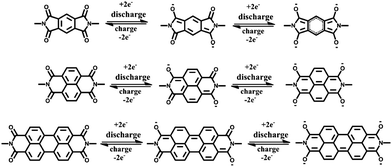 | ||
| Scheme 2 Electrochemical redox reactions of Li ions with PI polymers based on anhydride functional groups. | ||
The cycling performances of the samples were investigated as shown in Fig. 2d. During long cycling, the discharge capacity stability of PI-3 is the best. After 65 cycles, the discharge capacity retention of the sample is about 74.1% (57.9 mA h g−1). For PI-2, after 30 cycles, there is only 66.2% (68.5 mA h g−1) of the capacity retention. The capacity of PMDA-based PI-1 decreases gradually with the increase of cycle number. Among all the samples, PI-3 shows the best electrochemical performance. The difference in the capacity of three PIs is usually caused by the diversity of the molecule structure and the active sites of the aromatic dianhydride monomer for lithium insertion/extraction, as well as the current density used in the measurement. For example, there are the same active sites for PI-2 and PI-3. PI-3 with the relatively large molecule structure delivers the low discharge capacity as compared with PI-2 with the relatively small molecule structure.
On the other hand, taking the structural feature of three PIs into consideration, the porosities of PI-1, PI-2 and PI-3 were discussed, N2 adsorption experiments were explored at 77 K (Fig. 3a). The Brunauer–Emmet–Teller (BET) and Langmuir surface areas were obtained as 508 and 685 m2 g−1 for PI-1, and 200 and 307 m2 g−1 for PI-2, respectively. Also, the fit of the adsorption data using the Horvath–Kawazoe method demonstrates the pore width distribution about 5.4 Å for PI-1 and 4.1 Å for PI-2 (Fig. 3b). Subsequently, by analyzing these sorption curves, the higher N2 uptake of PI-1 than PI-2 might be caused by the smaller size of linker PMDA than NTCDA. In contrast, in the case of PI-3, almost no adsorption was observed, which could be ascribed to the interpenetration of networks along with length increasing of the linker.
Due to the higher surface area and microporosity, PI-1 was selected to test its H2 storage and CO2 capture abilities. Fig. 3c exhibits that PI-1 can adsorb a moderate amount of H2 (74 cm3 g−1, 0.66 wt%) at 77 K and 1 atm, and it decreased to 57 cm3 g−1 (0.51 wt%) at 87 K. The enthalpy of H2 adsorption for PI-1 is calculated using the modified Clausius–Clapeyron equation (Fig. S8, ESI†) by analyzing the isotherms at 77 K and 87 K.16 The result reveals that PI-1 presents a high initial Qst value, that is 11.7 kJ mol−1 at initial loading, which is higher than or comparable to other porous organic materials, such as BILPs (7.8–8.3 kJ mol−1),17 COFs (6.0–7.0 kJ mol−1),18 –OH functionalized POFs (8.3–9.0 kJ mol−1),19 tetrazine-based TzFs (7.8–8.2 kJ mol−1),20 metalated POPs (8.1–9.6 kJ mol−1),21 APOPs (7.6–9.4 kJ mol−1).22 The high Qst value proves the strong interaction between pore wall and the absorbed H2 molecule. Furthermore, micropore size distribution for PI-1 (5.4 Å) is close to the size of about two H2 molecule (2.8 Å × 2), which may help enhancing the interaction between the H2 molecules and the framework. PI-1 may have application in H2 storage. For CO2 capture, 1 shows average CO2 adsorption capacity of about 41 cm3 g−1 at 273 K and 1 atm, 23 cm3 g−1 at 298 K and 1 atm (Fig. 3d), respectively. Additionally, PI-1 shows selective adsorption of CO2 over CH4 and N2. The CO2/CH4 selectivity at 1 atm increases from about 4.3 at 273 K to 8.1 at 298 K.
In conclusion, three polyimides polymers are successfully synthesized by the condensation reaction of A3-type cross-linker with a series of difunctional aromatic dianhydride. The reversible redox enolation of carbonyl groups of polyimides polymers provides a promising energy-storage system as cathode materials for Li-ion batteries. Though these materials only show moderate discharge capacities and cycle performance, such organic materials may exhibit broader application prospects than the conventional transition-metal-oxide-based materials. Meanwhile, the polymer PI-1 can selectively adsorbs CO2 over CH4 and N2 and exhibits the high Qst value of H2.
Acknowledgements
The financial support from the 973 Program (2012CB821700), NSFC (21031002, 21202088 and 51073079), and Specialized Research Fund for the Doctoral Program of Higher Education (20130031130001).References
- (a) I. D. Scott, Y. S. Jung, A. S. Cavanagh, Y. F. Yan, A. C. Dillon, S. M. George and S. H. Lee, Nano Lett., 2011, 11, 414 CrossRef CAS PubMed; (b) L. X. Yuan, Z. H. Wang, W. X. Zhang, X. L. Hu, J. T. Chen, Y. H. Huang and J. B. Goodenough, Energy Environ. Sci., 2011, 4, 269 RSC; (c) M. Zhang, B. H. Qu, D. N. Lei, Y. J. Chen, X. Z. Yu, L. B. Chen, Q. H. Li, Y. G. Wang and T. H. Wang, J. Mater. Chem., 2012, 22, 3868 RSC; (d) J. Y. Luo and Y. Y. Xia, Adv. Funct. Mater., 2007, 17, 3877 CrossRef CAS; (e) X. P. Gao and H. X. Yang, Energy Environ. Sci., 2010, 3, 174 RSC; (f) Y. J. Fu, X. W. Li, X. L. Sun, X. H. Wang, D. Q. Liu and D. Y. He, J. Mater. Chem., 2012, 22, 17429 RSC.
- K. Liu, J. M. Zheng, G. M. Zhong and Y. Yang, J. Mater. Chem., 2011, 21, 4125 RSC.
- (a) F. Zhang, X. Yang, F. Zhu, J. Huang, W. He, W. Wang and H. Li, Chem. Sci., 2012, 3, 476 RSC; (b) L. B. Sun, Y. C. Zou, Z. Q. Liang, J. H. Yu and R. R. Xu, Polym. Chem., 2014, 5, 471 RSC; (c) T. Ben, H. Ren, S. Q. Ma, D. P. Cao, J. H. Lan, X. F. Jing, W. C. Wang, J. Xu, F. Deng, J. M. Simmons, S. L. Qiu and G. S. Zhu, Angew. Chem., Int. Ed., 2009, 48, 9457 CrossRef CAS PubMed; (d) H. Ren, T. Ben, E. S. Wang, X. F. Jing, M. Xue, B. B. Liu, Y. Cui, S. L. Qiu and G. S. Zhu, Chem. Commun., 2010, 46, 291 RSC; (e) Z. G. Wang, B. F. Zhang, H. Yu, L. X. Sun, C. L. Jiao and W. S. Liu, Chem. Commun., 2010, 46, 7730 RSC.
- (a) P. Poizot and F. Dolhem, Energy Environ. Sci., 2011, 4, 2003 RSC; (b) H. Nishide, K. Koshika and K. Oyaizu, Pure Appl. Chem., 2009, 81, 1961 CrossRef CAS.
- (a) X. Y. Han, G. Y. Qing, J. T. Sun and T. L. Sun, Angew. Chem., Int. Ed., 2012, 51, 5147 CrossRef CAS PubMed; (b) X. Y. Han, C. X. Chang, L. J. Yuan, T. L. Sun and J. T. Sun, Adv. Mater., 2007, 19, 1616 CrossRef CAS; (c) Y. L. Liang, P. Zhang and J. Chen, Chem. Sci., 2013, 4, 1330 RSC.
- (a) H. Chen, M. Armand, M. Courty, M. Jiang, C. P. Grey, F. Dolhem, J. M. Tarascon and P. Poizot, J. Am. Chem. Soc., 2009, 131, 8984 CrossRef CAS PubMed; (b) M. Yao, H. Senoh, S. Yamazaki, Z. Siroma, T. Sakai and K. Yasuda, J. Power Sources, 2010, 195, 8336 CrossRef CAS PubMed; (c) Z. Song, H. Zhan and Y. Zhou, Chem. Commun., 2009, 448 RSC; (d) H. Chen, M. Armand, G. Demailly, F. Dolhem, P. Poizot and J. M. Tarascon, ChemSusChem, 2008, 1, 348 CrossRef CAS PubMed; (e) W. Xu, A. Read, P. K. Koech, D. H. Hu, C. M. Wang, J. Xiao, A. B. Padmaperuma, G. L. Graff, J. Liuc and J. G. Zhang, J. Mater. Chem., 2012, 22, 4032 RSC; (f) D. Haringer, P. Novak, O. Haas, B. Piro and M. C. Pham, J. Electrochem. Soc., 1999, 146, 2393 CrossRef CAS PubMed; (g) T. Le Gall, K. H. Reiman, M. C. Grossel and J. R. Owen, J. Power Sources, 2003, 119, 316 CrossRef.
- (a) M. Armand, S. Grugeon, H. Vezin, S. Laruelle, P. Ribière, P. Poizot and J. M. Tarascon, Nat. Mater., 2009, 8, 120 CrossRef CAS PubMed; (b) S. W. Wang, L. J. Wang, K. Zhang, Z. Q. Zhu, Z. L. Tao and J. Chen, Nano Lett., 2013, 13, 4404 CrossRef CAS PubMed.
- (a) Z. P. Song, H. Zhan and Y. H. Zhou, Angew. Chem., Int. Ed., 2010, 49, 8444 CrossRef CAS PubMed; (b) Z. Song, T. Xu, M. L.Gordin, Y. B. Jiang, I. T. Bae, Q. Xiao, H. Zhan, J. Liu and D. Wang, Nano Lett., 2012, 12, 2205 CrossRef CAS PubMed; (c) D. J. Kim, S. H. Je, S. Sampath, J. W. Choi and A. Coskun, RSC Adv., 2012, 2, 7968 RSC; (d) H. G. Wang, S. Yuan, D. L. Ma, X. L. Huang, F. L. Meng and X. B. Zhang, Adv. Energy Mater., 2013 DOI:10.1002/aenm.201301651.
- (a) J. Q. Geng, J. P. Bonnet, S. Renault, F. Dolhem and P. Poizot, Energy Environ. Sci., 2010, 3, 1929 RSC; (b) S. Renault, J. Q. Geng, F. Dolhem and P. Poizot, Chem. Commun., 2011, 47, 2414 RSC.
- (a) M. K. Gosh and K. L. Mittal, in Polyimides: Fundamentals and Applications, Marcel Dekker, New York, 1996 Search PubMed; (b) D. Wilson, H. D. Stenzenberger and P. M. Hergenrother, Polyimides, Blackie, Glassgow, 1999 Search PubMed; (c) H. Lim, W. J. Cho, C. S. Ha, S. Ando, Y. K. Kim, C. H. Park and K. Lee, Adv. Mater., 2002, 18, 1275 CrossRef; (d) H. D. Park, K. Y. Ahn, M. A. Wahab, N. J. Jo, I. Kim and C. S. Ha, Macromol. Res., 2003, 11, 172 CrossRef CAS.
- J. Wakita, H. Sekino, K. Sakai, Y. Urano and S. Ando, J. Phys. Chem. B, 2009, 113, 15212 CrossRef CAS PubMed.
- (a) B. Z. Jang, C. G. Liu, D. Neff, Z. N. Yu, M. C. Wang, W. Xiong and A. Zhamu, Nano Lett., 2011, 11, 3785 CrossRef CAS PubMed; (b) S. W. Lee, N. Yabuuchi, B. M. Gallant, S. Chen, B. S. Kim, P. T. Hammond and Y. Shao-Horn, Nat. Nanotechnol., 2010, 5, 531 CrossRef CAS PubMed.
- (a) K. V. Rao, R. Haldar, C. Kullkarni, T. K. Maji and S. J. George, Chem. Mater., 2012, 24, 969 CrossRef CAS; (b) O. K. Farha, A. M. Spokoyny, B. G. Hauser, Y. S. Bae, S. E. Brown, R. Q. Snurr, C. A. Mirkin and J. T. Hupp, Chem. Mater., 2009, 21, 3033 CrossRef CAS.
- (a) S. R. Forrest, Chem. Rev., 1997, 97, 1793 CrossRef CAS PubMed; (b) C. K. Chan, E. G. Kim, J. L. Brédas and A. Kahn, Adv. Funct. Mater., 2006, 16, 831 CrossRef CAS.
- Z. G. Wang, B. F. Zhang, H. Yu, G. Y. Li and Y. J. Bao, Soft Matter, 2011, 7, 5723 RSC.
- M. Dincă and J. R. Long, J. Am. Chem. Soc., 2005, 127, 9376 CrossRef PubMed.
- (a) M. G. Rabbani and H. M. El-Kaderi, Chem. Mater., 2012, 24, 1511 CrossRef CAS; (b) M. G. Rabbani, A. K. Sekizkardes, O. M. El-Kadri, B. R. Kaafarani and H. M. El-Kaderi, J. Mater. Chem., 2012, 22, 25409 RSC.
- H. Furukawa and O. M. Yaghi, J. Am. Chem. Soc., 2009, 131, 8875 CrossRef CAS PubMed.
- A. P. Katsoulidis and M. G. Kanatzidis, Chem. Mater., 2011, 23, 1818 CrossRef CAS.
- D. S. Zhang, Z. Chang, Y. B. Lv, T. L. Hu and X. H. Bu, RSC Adv., 2012, 2, 408 RSC.
- M. H. Weston, O. K. Farha, B. G. Hauser, J. T. Hupp and S. T. Nguyen, Chem. Mater., 2012, 24, 1292 CrossRef CAS.
- W. C. Song, X. K. Xu, Q. Chen, Z. Z. Zhuang and X. H. Bu, Polym. Chem., 2013, 4, 4690 RSC.
Footnote |
| † Electronic supplementary information (ESI) available: Experimental details, characterization of the materials and gas sorption isotherms. See DOI: 10.1039/c3ra45563g |
| This journal is © The Royal Society of Chemistry 2014 |

